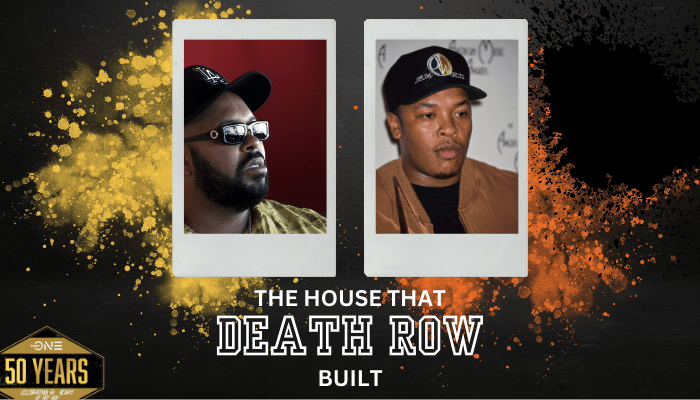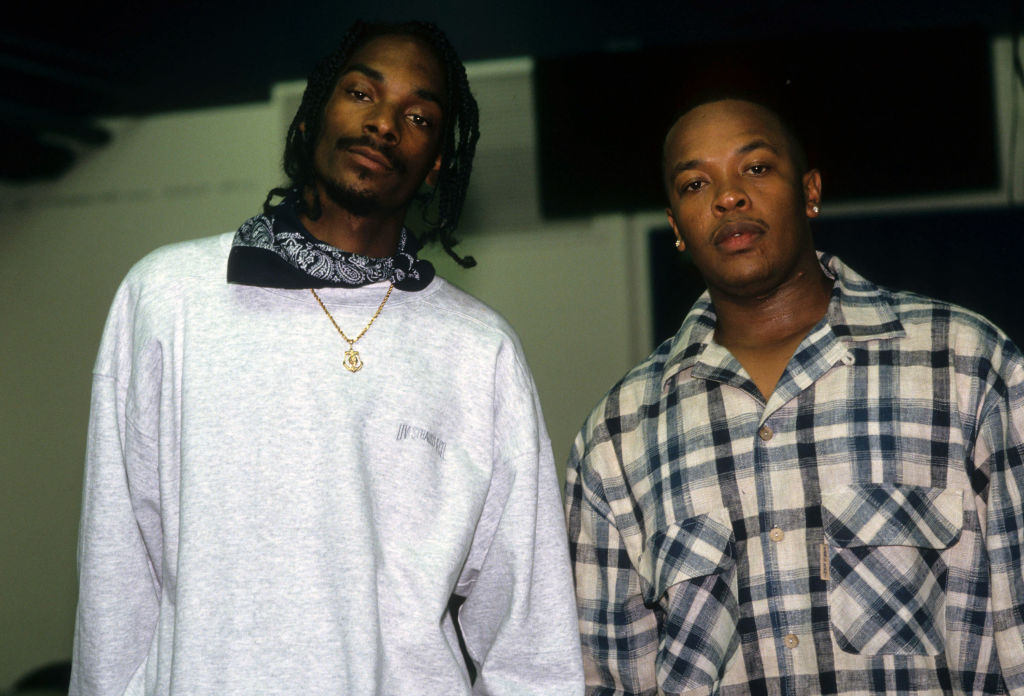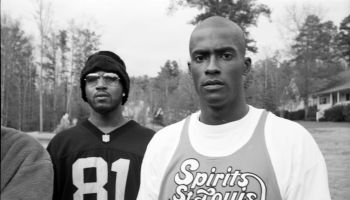
Source: General / Radio One
As we celebrate 50 years of Hip Hop, there is no way we cannot mention an iconic label that is just as known for being infamous as it is for being influential. It is a legacy that is shrouded in magnificent highs and devastating lows.
We are talking about Hip Hop’s crown jewel in the West: Death Row Records.

Source: Al Pereira / Getty
Formed in 1991, the label was co-owned and operated by prolific producer Dr. Dre and former bodyguard Marion “Suge” Knight. From its launch, Death Row quickly rose to become the top label of the 1990s. Projects from artists such as Dre, Snoop Doggy Dogg and 2Pac became instant classics.
However, financial troubles, legal scuffs, and the death of the label’s most iconic artist would make Death Row’s downfall happen as quickly as its rise. Despite that, we still acknowledge the label as a cornerstone of Hip Hop. Make no mistake that the label’s impact is still felt to this day.
This is the house that Death Row built.
The post Hip Hop History Month: The House That Death Row Built appeared first on Black America Web.
Hip Hop History Month: The House That Death Row Built was originally published on blackamericaweb.com
1. 1991
Following his departure from the rap group N.W.A. and its label home, Ruthless Records (which is a long story for another day), Dr. Dre began the process of starting a new label with former bodyguard Marion “Suge” Knight, fellow rapper The D.O.C. and SOLAR Records founder Dick Griffey. It was originally set to be named Future Shock. However, D.O.C. and Suge’s business partner, Michael “Harry-O” Harris, suggested to change the name to Def Row (a play on Def Jam). However, due to some legalities over the name, it was eventually re-christened Death Row.
As for how it was funded, we somewhat have to thank a man named Rob Van Winkle… a.k.a. Vanilla Ice.
According to legend, Knight and his bodyguards first approached the “Ice Ice Baby” hitmaker while he was eating dinner at a LA restaurant. Knight would pop up on Ice on several occasions until one fateful night at the Bel Age Hotel, where Knight allegedly threatened to toss the rapper from the balcony of his 15th floor penthouse suite unless he signed over the royalties to his signature track to his former acquaintance, Mario “Chocolate” Johnson, who was Suge’s artist at the time.
2. 1992
Following the release of the Deep Cover soundtrack, Death Row Records dropped Dr. Dre’s solo debut, The Chronic, in December 1992. Led by the hit singles “Nothin But a ‘G’ Thang,” “Let Me Ride” and the Eazy-E diss record “F*ck Wit Dre Day,” the album went on to sell over 3 million albums and peaked at #3 on the Billboard 200.
With appearances from Death Row’s early roster, which included Snoop Doggy Dogg, Tha Dogg Pound, Warren G and The Lady of Rage, this was the official launch of Death Row as a label and a Hip Hop juggernaut.
3. 1993
Following notable appearances on The Chronic and two years of work, Snoop Doggy Dogg would finally release his debut album, Doggystyle, in October 1993. With much fanfare, Doggystyle sold more units than The Chronic on its release, debuting at #1 on the Billboard 200 and going 4x platinum. Pushing more into Death Row’s sound of G-Funk (a gangsta rap twist to George Clinton’s P-Funk), it would be lauded by critics as one of the most influential albums of the 1990s.
Unfortunately, shortly after the album’s release, Snoop was charged with first degree murder in the shooting death of gang member Phillip Woldermariam. He would be cleared on all charges three years later.
4. 1994
Death Row’s dominance would continue with the release of the Above The Rim soundtrack. Featuring the hit singles “Regulate” (by Warren G and Nate Dogg) and “Afro Puffs” (by The Lady of Rage), the soundtrack sold over 2 million units, a then-unprecedented feat for Hip Hop soundtracks. The label would follow that up with the soundtrack to Snoop Dogg’s short film Murder Was The Case (based on his Doggystyle track of the same name).
Despite Snoop’s pending murder trial and growing backlash from political figureheads, Death Row was only beginning to hit its stride.
5. 1995
1995 would be a turning point in Death Row’s history. That August, during the 1995 Source Awards, Suge Knight would use his small window of stage time to publicly call out then-rising mogul Sean “Puffy” Combs, the head of NY-based label Bad Boy Records (which we’ll discuss later this month).
As he criticized Diddy’s “scene-stealing” habits in his artists’ music videos, he encouraged artists looking to grab the spotlight for themselves to come to Death Row.
Another key moment in Knight’s speech was his support for established rapper Tupac Shakur (2Pac), whom Knight visited while he was incarcerated for sexual abuse. Knight would later post $1.4 million bond for Pac, who then became Death Row’s newest signee. Pac quickly pledged his allegiance to the label, blasting both Puffy and his artist, The Notorious B.I.G., for allegedly setting him up to be shot outside of NY’s Quad Studios one year earlier. Thus, the East Coast/West Coast rap war began.
6. 1996
By 1996, operations at Death Row were changing drastically. Growing weary of the growing violence within the label, mostly at the hands of Suge Knight, Dr. Dre left Death Row in March of that year. He would go on to found Aftermath Records with Interscope’s Jimmy Iovine. However, with the East/West rap rivalry escalating to deadly proportions, Death Row’s biggest tragedy would come later that year.
On September 7, 1996, Tupac Shakur was shot at a stop light in Las Vegas, shortly after he and Knight left the MGM Grand Casino for a Mike Tyson fight. Shakur would succumb to his injuries 6 days later at the age of 25. The murder would go mostly unsolved until 2023, when Duane “Keefe D” Davis was charged with murder in the case.
Despite the tragedy, Death Row tried to soldier on, as 2Pac’s posthumous release, The Don Killuminati: 7 Day Theory, and Snoop’s Tha Doggfather both achieved multi-platinum status.
7. 1997
 Source:Getty
Source:Getty
In February of 1997, Suge Knight was sentenced to nine years in prison for parole violation, allegedly stemming from the 1996 fight in Vegas preceding 2Pac’s murder. With Knight’s incarceration, Interscope dropped their distribution deal with Death Row. Many of the label’s acts would soon leave, including its remaining flagship artist, Snoop Doggy Dogg.
8. 2001-2006
Following his release from prison in 2001, Knight would attempt to pick up the pieces to his crumbling empire. That would include the brief signings of Crooked I, Petey Pablo, and, most notably, TLC’s Lisa “Left Eye” Lopes (under the pseudonym N.I.N.A.). The label would also be renamed Tha Row in an attempt to revamp its image in the mainstream.
However, that would not work. In 2006, Death Row and Knight filed for Chapter 11 Bankruptcy, and it appeared that the label was finished.
Until…
9. 2022
Prior to his appearance on the Super Bowl LVI Halftime Show, it was announced that Snoop Dogg would return to the label that launched his career – this time, as the sole owner. After seeing numerous ownership changes over the years, Snoop acquired Death Row from MNRK Music Group, which is owned by private equity fund Blackstone.
“It feels good to have ownership of the label I was part of at the beginning of my career and as one of the founding members,” he said in a statement. “This is an extremely meaningful moment for me. I would like to personally thank the teams at Blackstone, MNRK and especially David Kestnbaum, who worked collaboratively with me over several months to make this exciting homecoming a reality.”
Snoop signed off his statement by adding: “I’m looking forward to building the next chapter of Death Row Records.”
10. Present Day
Since Snoop’s acquiring of the label (and with Suge Knight now serving a 28-year prison sentence for voluntary manslaughter), Death Row is looking to expand its musical horizons. Along with its historical back catalog, Death Row is also looking over new artists, from marachi artist Julian Torres y Mariachi Cenzontle to soul singer October London.
With over 30 years of unique musical production and timeless artists, Death Row Records remains a pillar of music history, and its influence continues to be felt throughout Hip Hop and beyond.













